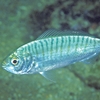General Description
Body slender; head large, bony; snout blunt without projecting spines; scales tiny, those along the dorsal-fin bases large and thorn-like. Reddish to greyish brown above, pale below; fan-like pectoral fins greenish-grey with blue spots, a blue margin and black blotch scattered with white spots near the base. To 50 cm.
Biology
This species is seen more often by anglers than divers. It is commercially fished in southern Australia, and is considered very good eating.
Habitat
Usually on soft bottoms in offshore waters, occasionally entering deeper parts of bays, in depths of 2-200 m.
Soft substrates
Distribution guide
New Zealand and possibly South Africa. Southern Australia. In Victoria, rarely in Port Phillip.
Species Group
Depth
Shallow (1-30 m)
Deep ( > 30 m)
Water Column
Max Size
50 cm
Diet
Carnivore
Commercial Species
Yes
Global Dispersal
Recorded in Australia
Conservation Status
- DSE Advisory List : Not listed
- EPBC Act 1999 : Not listed
- IUCN Red List : Least Concern





